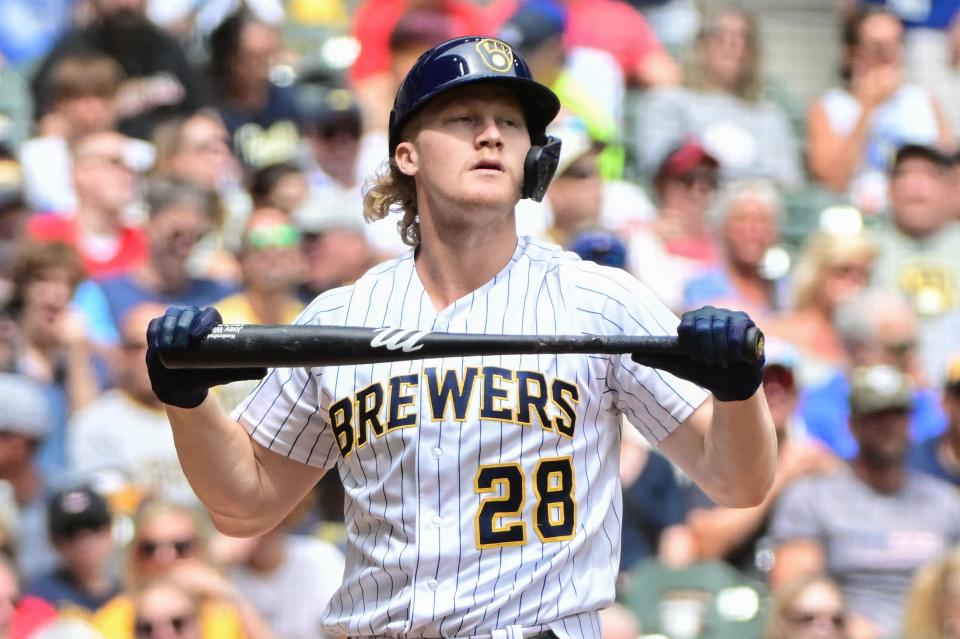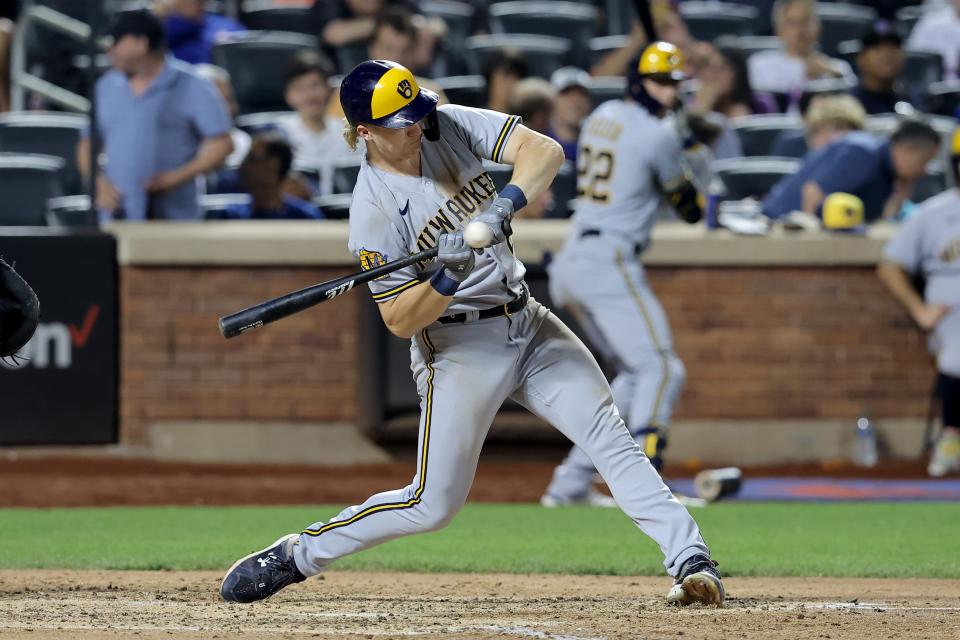What could a late-season swing change mean for Joey Wiemer for 2024?
It didn't conclude with much fanfare, but Joey Wiemer's rookie campaign for the Milwaukee Brewers had plenty of positives.
Wiemer was supposed to begin the season in the minors, but was thrust into the majors almost immediately when Luis Urías went down with an injury on opening day. Wiemer then became the every day centerfielder when Garrett Mitchell injured his shoulder just two weeks later.
For much of the season, Wiemer more than held his own. The injury to Mitchell, who was penciled in to be the primary centerfielder for the Brewers, was figured to be a massive loss for Milwaukee, but Wiemer turned around and delivered elite defense at a position he had rarely played coming up.
Wiemer's offense was inconsistent but after a two-homer game on June 7 against the Orioles he had a .727 on-base plus slugging percentage. He had an .848 OPS in June and across a two-month sample between June and July he posted a .766 OPS.
Of course, that level of offense didn't last. Wiemer had one extra-base hit and slugged .238 in 19 games during August. His playing time dwindled to the point he received only 22 plate appearances over the first 16 days of September.
On Sept. 17 the Brewers optioned him to Class AAA Nashville while he carried a .204/.283/.362 slash line.
Wiemer didn't get a plate appearance the rest of the way for the Brewers, but there was still something he did between being optioned and the end of the season that was eye-catching.

An adjustment made after going back to the minors
One of the first things Wiemer did after being optioned to Nashville in September was make a significant adjustment to the bat flick he used as a timing mechanism.
Central to Wiemer's unique approach at the plate is doing whatever he thinks he needs to in order to avoid feeling stagnant. This leads to a series of unusual and unique movements, including flicking the bat toward the ground prior to moving his lower half and swinging.
The level of movement in Wiemer's swing varies throughout the season, but toward the tail end of his time with Milwaukee he was bringing the bat almost parallel with the ground before loading his hands back.
When Wiemer was optioned to Nashville, he tinkered with his bat movement, keeping the bat head above his shoulder as he moved into a hitting position. His hands were also kept higher the entire time, decreasing the amount of upper body movement.
Compare Wiemer’s swing from the tail end of his time in the majors in the video above to how it looked during batting practice prior to the Brewers playoff series with the Diamondbacks in October.
New-look Joey Wiemer ft. Gambino pic.twitter.com/N2AjiIZYOl
— Curt Hogg (@CyrtHogg) October 3, 2023
Watch, in the first clip from August 22 against the Twins, how far Wiemer’s hands are still moving. The pitcher, Cole Sands, is releasing the ball and Wiemer is just starting loading his hands, bringing them back from just above the belt to all the way up by his back shoulder.
By the time his hands are finally loaded into a hitting position, the ball is more than halfway to the plate. This isn't necessarily a big deal in and of itself — some hitters do still bring their hands backward while the front half of the body moves forward with the swing to create a rubber-band effect before snapping forward.
But between the distance his hands had to move and the timing of the body movement needing to be perfectly synchronized with the pitch, all the moving parts can create for a challenge.
Clearly Wiemer (and Sounds hitting coach Al LeBoeuf) thought something was askew. Tweaks were made right away and by the time he was back in Milwaukee for the playoffs, Wiemer’s swing was simpler and more connected.
Why Wiemer had to make a change

He played excellent defense and was holding his own at the plate through three months, sporting a .685 OPS with 11 homers at the end of June.
The league, as it tends to do, adjusted.
Pitchers, especially right-handers, attacked Wiemer more relentlessly with breaking balls and that set off a slide at the plate for Wiemer. Pitchers threw him 38% breaking balls in June, then 39.5% in July, 44.4% in August and 47.1% in September. For the most part, he stopped seeing hittable fastballs.
Wiemer's numbers at the plate had an inverse relationship to the breaking ball usage. He had an .848 OPS in June, but after that, his performance dipped to .649 in July, .505 in August and .438 in September.
Wiemer finished the year batting only .175 with a .568 OPS against right-handers. The primary culprit was his struggle against breaking stuff. Wiemer batted .140 and slugged .198 against curveballs, sliders and sweepers from righties, both of which were the lowest numbers in baseball, minimum 500 pitches seen.
Wiemer was worth plus-7 runs against every other category of pitches aside from breaking balls, according to Statcast, but his minus-15 batting runs against sliders, sweepers and curveballs ultimately put a major damper on his overall offensive output.
There are plenty of good MLB hitters who struggle with breaking balls
We’ve clearly established by now what Wiemer’s Kryptonite is.
But there indeed may be some hope for Wiemer’s offensive profile even given those struggles with spin.
Wiemer is certainly not the first batter to struggle with sliders on the outer half or off the plate from same-side pitchers, and having difficulty with that pitch does not preclude offensive success.
J.D. Martinez is a good hitter. As are Austin Riley and Marcell Ozuna. Nick Castellanos, Carlos Correa, Jake Burger, Christopher Morel, Trea Turner, Brent Rooker, Willy Adames and JD Davis are all pretty dangerous at the plate, too.
They all whiffed at a higher rate against right-handed sliders to the outer half or off the plate than Wiemer did last year.
Wiemer has some of the tools in his game to, just like the aforementioned more established players, still be a good hitter even if one specific pitch gives him trouble.
Perhaps some adjustments at the plate similar to what Wiemer showed at the end of last season can allow him to make the necessary adjustments and reach his unrealized potential with the bat.
What, exactly, Wiemer's swing looks like when he reports for spring training remains to be seen. He's a hitter who needs to feel loose in the box and makes adjustments from there based on what his body is telling him. Wiemer is likely always going to utilize some quirky movements at the plate, and those were a part of what had made him successful coming through the ranks.
Now, it's all about Wiemer finding the right balance at the plate that allows him to stay loose and athletic while also being able to identify and react better to breaking pitches.
If he can do that, look out.
This article originally appeared on Milwaukee Journal Sentinel: Brewers' Joey Wiemer made swing change late in 2023

